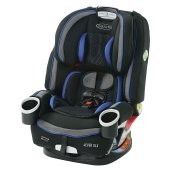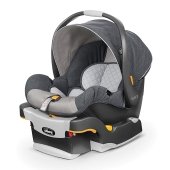
In the U.S., the federal government has allowed each state to craft its own laws regarding child car seats. The result is varying regulations, which puts the onus on anyone driving with a child as a passenger to know the car seat laws in the states in which they reside or will be traveling in.
This can be challenging, especially for people who live in one state and frequently travel into a bordering state. It also adds extra research for those taking a vacation that requires travel through multiple U.S. states.
To help ease the workload and take the guesswork out of car seat laws in each U.S. state, here is the information you need to know when traveling with children throughout the U.S. in 2020.
The 50 states, plus the District of Columbia, are listed by region and then separated by division according to the U.S. Census Bureau.
It should be noted that car seat laws in some states are not as stringent as recommendations issued by safety experts and pediatricians.

Jump to:
States in the Northeast Region

New England
Connecticut:
The Constitution State requires any child under age 8 and weighing less than 60 pounds to be in a car seat in the back seat of a vehicle. Specifically:
- Rear-facing child seat with 5-point harness – required for any child under 2 years old or less than 30 pounds, regardless of age;
- Forward-facing child seat with a harness restraint – children must be a minimum of 2 years old or between 30 – 40 pounds, regardless of age;
- Booster seat – children must be a minimum of 5 years old or between 40 – 60 pounds, regardless of age; must be used with a lap and shoulder seat belt system and according to the weight and height limits set by the car seat manufacturer;
- Vehicle’s seat belt system – children must be a minimum of 8 years old AND must weigh 60 or more pounds.
Maine:
The Pine Tree State requires children under age 12 and less than 100 pounds to ride in the back seat, if possible. Additionally:
- Car seat – for children under 40 pounds in accordance with the car seat manufacturer’s instructions;
- Booster seat – for children under age 8 weighing between 40 and 80 pounds;
- Vehicle’s seat belt system – for children ages 8 to 18 and more than four feet, nine inches tall.
Massachusetts:
The Bay State requires all children under age 8 to ride in a child seat unless the child is over four feet, nine inches tall. Children ages 8 through 12 should be secured using the vehicle’s seat belt system.
New Hampshire:
The Granite State’s law states that children younger than age 7 or less than four feet, nine inches tall must ride in a car seat.
The state is considering a new House Bill 251, which would require children under two years old to be in a rear-facing seat used in accordance with its manufacturer instructions.
Rhode Island:
The Ocean State requires children to be in a car seat if they are under 8 years old, less than four feet, nine inches tall, and less than 80 pounds. Additional requirements are:
- Rear-facing car seat in the back seat of the vehicle – required for infants and toddlers under age 2 or less than 30 pounds;
- Forward-facing car seat with a harness in the back seat of the vehicle – required for children ages 2 or older who are over the weight and height requirements of a rear-facing seat.
- Vehicle’s seat belt system in the back seat – required of any child under age 8 who is four feet, nine inches or taller, or 80 pounds or more;
- Vehicle’s seat belt system in any passenger seat – any child over age 8, but under age 18.
Vermont:
The Green Mountain State requires all children in a vehicle under age 18 to be properly restrained as such:
- Rear-facing car seat not installed in front of an airbag – mandatory for youngsters under age 1 or less than 20 pounds;
- Forward-facing car seat – required for children ages 1 to 8 who weigh more than 20 pounds;
- Vehicle’s seat belt system – required for children ages 8 to 18.
Middle Atlantic
New Jersey:
In the Garden State, children are required to ride in the back seat of the vehicle and be secured in these child restraint systems accordingly:
- Rear-facing car seat with a 5-point harness – if child is under age 2 and weighs less than 30 pounds;
- Rear-facing or forward-facing car seat – if child is under age 4 and weighs less than 40 pounds;
- Forward-facing car seat or booster seat – if child is under age 8 and less than four feet, nine inches tall.
New York:
The Empire State, under its NYS Vehicle & Traffic Law, requires children to be in an applicable child restraint system until age 8, specifically:
- Rear-facing car seat – required for children under age 2, unless child reaches maximum height and weight requirements of the seat;
- Forward-facing car seat – required for children under age 4 and under 40 pounds;
- Booster seat – required for children ages 4 to 8 or children under 4 and over 40 pounds;
- Vehicle’s seat belt system – for children ages 8 through 16.
Pennsylvania:
The Keystone State has the following requirements for child passenger restraint systems:
- Rear-facing car seat – required for children under age 2;
- Forward-facing car seat – required for children under age 4;
- Booster seat – required for children who are 4 years old, but younger than age 8 who weigh less than 40 pounds;
- Vehicle’s seat belt system – required for children 4 years of age, but younger than age 8 who weigh more than 80 pounds or who are four feet, nine inches or taller.
States in Midwest Region

East North Central
Indiana:
The Hoosier State requires children under age 8 to be in a car seat in accordance with the car seat manufacturer’s instructions. Children ages 8 to 16 must be secured with the vehicle’s seat belt system.
Illinois:
The Prairie State, under its child passenger protection act, requires children under age 2 to ride in a rear-facing child safety seat, and children under age 8 to ride in appropriate car seats, including booster seats. Children over 40 pounds can use the vehicle’s seat belt system, but must ride in the back seat of the vehicle.
Michigan:
The Great Lakes State requires children under the age of 16 to wear a seat belt when riding in a vehicle. Additionally, children under age 4 must sit in a car seat in the back seat of the vehicle. However, if a vehicle does not have a rear seat or if the back seat is occupied by other children under age 4, the child can ride in the front seat in either a rear-facing or forward-facing car seat as long as the front passenger airbag is deactivated. The law also requires children under age 8 and less than four feet, nine inches tall to ride in a booster seat.
Ohio:
The Buckeye State requires children up to age 15 to be secured in a child restraint system as follows:
- Rear-facing or forward-facing car seat – required for children up to age 4 or less than 40 pounds;
- Booster seat – required for children under age 8 and less than four feet, nine inches in height.
- Vehicle’s seat belt system – required for children ages 8 to 15.
Wisconsin:
The Badger State requires the following child restraint systems:
- Rear-facing car seat in the back seat of the vehicle – for children less than age 1 or less than 20 pounds and children ages 1 and older who weigh 20 pounds or less, or are less than age 4 or weigh less than 40 pounds;
- Forward-facing car seat – for children who are age 4 and older and at least 40 pounds, but younger than age 8 and less than 80 pounds and no more than four feet, nine inches in height;
- Booster seat or vehicle seat belt system – for children younger than 8 years old who outgrow the car seat’s height and weight maximum limit;
- Vehicle seat belt system – for children ages 8 and older who weigh more than 80 pounds and are taller than four feet, nine inches.
West North Central
Iowa:
The Hawkeye State has the following child restraint system laws:
- Rear-facing car seat – required for infants under age 1 and less than 20 pounds;
- Forward-facing car seat – required for children ages 1 to 6;
- Booster or vehicle’s seat belt system – required for children ages 6 to 17.
Kansas:
The Sunflower State mandates:
- Rear-facing car seat – for children under the age of 4;
- Forward-facing car seat or booster seat – for children older than age 4, but younger than age 8 and weigh less than 80 pounds or are less than four feet, nine inches tall;
- Vehicle’s seat belt system – for children older than age 8.
Minnesota:
The North Star State requires children under age 8 to ride in a car seat unless the child is four feet, nine inches or taller.
Missouri:
The Show-Me State requires any child less than age 4 to ride in a car seat, regardless of weight. Additionally, the law states:
- Forward-facing car seat – required for children weighing less than 40 pounds, regardless of age;
- Booster seat – required for children ages 4 through 6 who also weigh between 40 and 80 pounds and are less than four feet, nine inches in height;
- Vehicle’s seat belt system – required for children 80 pounds or more and taller than 4 feet, nine inches.
Nebraska:
The Cornhusker State requires children up to age 8 to be transported in a car seat in the back seat of the vehicle. The law also states:
- Rear-facing car seat – required for children up to age 2 or until the child outgrows the maximum height and weight requirements of the car seat;
- Vehicle’s seat belt system – required for children ages 8 to 18.
North Dakota:
The Peace Garden State requires children under age 8 to be in a car seat. The vehicle’s seat belt system is required for children ages 8 to 17 or for children younger than age 8 who are at least four feet, nine inches tall.
South Dakota:
The Mount Rushmore State requires children under age 5 to be secured in a car seat when riding in a vehicle. The vehicle’s seat belt system is required for children ages 5 to 18 and children under 5 who are at least 40 pounds.
States in the South Region

South Atlantic
Delaware:
The First State mandates that children ride in car seats up to age 8 or 65 pounds. The vehicle’s seat belt system is required for children ages 8 to 15 or children who weigh 65 pounds. Children must ride in the back seat of the vehicle until age 12 or five feet, five inches in height.
District of Columbia (Washington, D.C.):
The capital of the United States of America requires children under 16 years of age to be secured in a vehicle using a car seat or the vehicle’s seat belt system. The law further states that children under age 8 must be seated in an infant car seat, convertible car seat, or booster seat that uses both the lap and shoulder belt.
Florida:
The Sunshine State requires children under age 6 to be in a federally approved car seat and children ages 6 to 16 to use a booster seat or the vehicle’s seat belt system.
Georgia:
The Peach State requires children ages 8 to 18 to be secured with a passenger restraint system. Children ages 8 and younger must ride in a car seat in the back seat of the vehicle. However, if the back seat is occupied by other younger passengers, the child can ride in the front passenger seat in a car seat or booster seat. The car seat should be appropriate for the child’s height and weight. If the child reaches four feet, nine inches in height before age 8, the vehicle’s seat belt system can be used instead of a car seat. Children weighing more than 40 pounds can ride wearing a lap-only seat belt.
Maryland:
The Old Line State mandates that all children under age 16 must be restrained in a car seat or the vehicle’s seat belt system. Children under the age of 8 must ride in a car seat in accordance with the car seat manufacturer’s requirements unless the child is four feet, nine inches or taller.
North Carolina:
The Tar Heel State requires children younger than age 8 and under 80 pounds to ride in a weight-appropriate car seat. Children who are under age 5 and 40 pounds must ride in the back seat of the vehicle. Children ages 8 to 16 must be restrained in a booster seat or by the vehicle’s seat belt system.
South Carolina:
The Palmetto State’s law mandates:
- Rear-facing car seat in back seat of the vehicle – for children from birth to age 2 or until the child exceeds the car seat manufacturer’s stated maximum weight and height limit for the seat;
- Forward-facing car seat with a harness in the back of the vehicle – for children age 2 and until the child exceeds the top level of the car seat’s height and weight limit;
- Booster seat in the back seat of the vehicle – for children ages 4 and older who have outgrown the forward-facing car seat’s height and weight requirements;
- Vehicle’s seat belt system – for children ages 8 years old OR at least 57 inches tall, as long as the lap belt fits properly across the child’s hips and thighs, the shoulder belt rests across the child’s chest, and the child’s knees bend over the vehicle’s seat edge when sitting straight back against the vehicle’s seat.
Virginia:
The Old Dominion State requires children to be properly secured in the following manner:
- Rear-facing car seat in the back seat of the vehicle – for children under age 1;
- Forward-facing car seat or booster seat – for children under age 8 according to the child’s weight and height as indicated by the car seat manufacturer’s guidelines;
- Vehicle’s seat belt system – for children ages 8 to 18.
Additionally, if the vehicle does not have a back seat, the car seat can be placed in the front passenger seat as long as the airbag is deactivated.
West Virginia:
The Mountain State requires children ages 8 to 18 to wear seat belts. Children under age 8 must ride in a car seat unless they are four feet, nine inches or taller, in which case they can be secured using the vehicle’s seat belt system.
East South Central
Alabama:
The Yellowhammer State mandates:
- Rear-facing car seat – for infants up to at least age 1 or 20 pounds;
- Forward-facing car seat – for children up to age 5 or 40 pounds;
- Booster seat – for children up to age 6;
- Vehicle’s seat belt system – for children ages 6 to 15 no matter where they sit in the vehicle.
Kentucky:
The Bluegrass State requires children 40 inches in height or less to be secured in a car seat. The law further states that children under age 8 who are between three feet, four inches and five feet, seven inches tall to ride in a booster seat.
Mississippi:
The Magnolia State requires all children under age 7 to ride in a car seat. A booster seat can be used when the child is between ages 4 and 7, weighs less than 65 pounds and is less than four feet, nine inches tall.
Tennessee:
The Volunteer State’s law states that children up to age 13 should sit in the back seat of a vehicle in accordance with the following:
- Rear-facing car seat – required for children under age 1 or 20 pounds or less;
- Forward-facing car seat – required for children ages 1 to 4 and weighing more than 20 pounds;
- Booster seat – required for children ages 4 to 9 and less than four feet, nine inches tall.
- Vehicle’s seat belt system – for children ages 9 to 16.
West South Central
Arkansas:
The Natural State requires children under age 16 to be properly secured when riding in a vehicle. Specifically, children under age 5 and less than 60 pounds must ride in a car seat, while children ages 5 to 8 and under four feet, nine inches tall must use a booster seat. The vehicle’s seat belt system must be used for children ages 6 to 15 and weighing 60 pounds or more.
Louisiana:
The Pelican State has the following regulations with regard to child restraint systems:
- Rear-facing car seat – required for children under age 2;
- Forward-facing car seat – required for children at least 2 years old who have outgrown the rear-facing seat and children up to 4;
- Booster seat – required for children between at least 4 years old who have outgrown a forward-facing harnessed seat and up to 9 years old;
- Vehicle’s seat belt system – required for children ages 9 and older who have outgrown the booster seat.
Oklahoma:
The Sooner State requires the use of a child restraint system for children under age 8, in particular:
- Rear-facing car seat – required for children up to age 2 or until the youngster meets the height and weight limit of the car seat, whichever comes first;
- Forward-facing car seat – required for children under age 4;
- Booster seat – required for children ages 4 to 8 who are less than four feet, nine inches tall;
- Vehicle’s seat belt system – required for children ages 8 and older or taller than four feet, nine inches.
Texas:
The Lone Star State’s transportation code requires any child under age 8 to ride in the applicable car seat according to the car seat manufacturer’s weight and height requirements. Children who are under age 8, but four feet, nine inches or taller and children up to age 17 must be secured using the vehicle’s seat belt system.
States in the West Region

Mountain
Arizona:
The Grand Canyon State requires child restraints for all children under age 16. In particular, car seats are required for children under age 5. Children ages 5 to 8 and less than four feet, nine inches in height must be in a booster seat.
Colorado:
The Centennial State’s child passenger safety law mandates:
- Rear-facing car seat in the back seat of the vehicle – required for children under age 1 and weighing less than 20 pounds;
- Rear-facing or forward facing car seat – required for children between the ages of 1 and 4 who weigh between 20 and 40 pounds;
- Forward-facing car seat or booster seat – required for children ages 4 and older or weighing more than 40 pounds;
- Vehicle’s seat belt system – required for children between the ages of 8 and 16.
Idaho:
The Gem State requires children ages 6 and younger to ride in a car seat. If all of the vehicle’s seat belts are in use, the child can ride unrestrained in the car seat in the back seat of the vehicle, if there is one. A child also can be held to be nursed or to address a physiological need.
New Mexico:
The child restraint law in the Land of Enchantment State applies to children under age 18, in particular:
- Rear-facing car seat in the back seat of the vehicle – required for children under age 1, but if there is no rear seat, the front passenger seat airbag must be deactivated;
- Forward-facing car seat – required for children ages 1 to 4 or those who weigh less than 40 pounds;
- Booster seat – required for children ages 5 to 6 or those who weigh less than 60 pounds;
- Vehicle’s seat belt system – required for children ages 7 through 12.
Montana:
The Treasure State requires children less than age 6 who weigh less than 60 pounds to be in a car seat while a passenger in a vehicle.
Utah:
The Beehive State requires children under age 8 to be in the appropriate car seat for their height and weight. Children who are younger than age 8 can only use the vehicle’s seat belt system if they are at least four feet, nine inches tall.
Nevada:
The Silver State doesn’t have very specific requirements for rear-facing, forward-facing, and booster seats. Nevada law simply requires children under age 6 who weigh less than 60 pounds to ride in a federally approved car seat according to the car seat manufacturer’s height and weight requirements.
They have some “best practices” beyond the law:
- Children 12 and under should ride in the back seat
- A car seat should be chosen based on child’s size and age
- Never put rear-facing seats in front of an airbag
- Front and rear passengers should always wear a safety belt or be secured in a car seat
Wyoming:
The Equality State requires children ages 8 and younger to be in a car seat in a vehicle. The car seat must be placed in the back seat of the vehicle unless all other rear seats are used by other children. In this case, the law prohibits rear-facing car seats to be positioned in front of an active airbag. Children ages 8 or younger can only use the vehicle’s seat belt system if the shoulder belt fits properly across the child’s chest and the lap belt fits properly across the child’s hips.
Pacific

Alaska:
The Last Frontier State requires:
- Rear-facing car seat – for children less than age 1 or less than 20 pounds;
- Forward-facing car seat – for children between the ages of 1 and 5 who weigh 20 pounds or more;
- Booster seat – for children between the ages of 5 and 8 who weigh between 21 and 65 pounds and are less than four feet, nine inches tall;
- Vehicle’s seat belt system – for children between the ages of 8 and 16 or children over age 4 who weigh 65 pounds or more and are taller than four feet, nine inches.
If a child is age 8 or older but does not meet the height and weight requirements, the decision to use a car seat or the vehicle’s seat belt system is left up to the driver of the vehicle.
California:
The Golden State’s vehicle code mandates children under age 8 ride in the back seat of a vehicle. Additionally:
- Rear-facing car seat – required for children less than age 2, unless the child is more than 40 pounds or three feet, four inches;
- Forward-facing car seat or booster seat – required for children under age 8;
- Vehicle’s seat belt system in the back seat of the vehicle – required for children under age 8 who are four feet, nine inches or taller;
- Vehicle’s seat belt system in any passenger seat of the vehicle – required for children ages 8 to 16.
Hawaii:
The Aloha State requires children under age 4 to ride in a car seat when traveling in a vehicle. Children between the ages of 4 and 8 are required to ride in either a car seat or booster seat. Children more than 40 pounds or over four feet, nine inches tall are allowed to be secured with the vehicle’s seat belt system, but must sit in the back seat of the vehicle. No matter where they sit in the car, seat belts are required to be worn by children ages 8 to 17.
Oregon:
The Beaver State mandates child safety systems accordingly:
- Rear-facing car seat – required for children up to age 2 or children older than age 2 who weigh 20 pounds or less;
- Forward-facing car seat – required for children who weigh 40 pounds or less;
- Booster seat – required for children under age 8 weighing more than 40 pounds and four feet, nine inches or shorter;
- Vehicle’s seat belt system – required for children ages 8 and older or taller than four feet, nine inches.
Washington:
The Evergreen State requires all children under age 13 to ride in the back seat of a vehicle whenever possible. Children under 2 should always ride in rear-facing car seats and should remain rear-facing for as long as possible until they outgrow the seat. Children 2 to at least 4 should ride in a forward-facing harnessed seat until they outgrow the seat. Children 4 feet, 9 inches or taller who have outgrown their booster seats are required to use the vehicle’s safety belt system.
UPDATED in 2020: Children older than 4, but shorter than 4 feet, 9 inches tall who have outgrown their harnessed seats must use booster seats. This means some kids must remain in booster seats until they’re 10 to 12 years old.
Safety Experts’ Recommendations vs U.S. Child Seat Laws
In many instances, the U.S. states’ enacted laws for child safety in a vehicle represent the very minimum in safety standards and may not represent best practices for safely securing your child in a vehicle.
Safety experts, such as the American Academy of Pediatrics and the National Highway Traffic Safety Administration (NHTSA), recommend more stringent car seat guidelines when transporting children in a vehicle.
For example, the following NHTSA guidelines are based on research and best practice scenarios.
- Rear-facing car seat – From birth to 12 months
- Forward-facing car seat – Ages 1 to 3, as long as the child has outgrown the maximum height and weight limit of the rear-facing car seat established by the car seat manufacturer
- Booster seat – Ages 4 to 7, as long as the child has outgrown the maximum height and weight limit of the rear-facing car seat set by the car seat manufacturer
- Vehicle’s seat belt system – Ages 8-12 or until the seat belt fits properly on the child. This means the shoulder belt should lie snugly across the child’s shoulder and chest and not cross the neck or face, and the lap belt should lie snugly across the child’s upper thighs, not the stomach.
Additionally, the NHTSA recommends children ride in the back seat of a vehicle at all times because it is the safest spot.
Editors choice
This post is also available in: Español (Spanish)



Why don’t these car seat have alerts for people forgetting a child in the seat ( ALARMS–SIRENS HOOKED ON THE SEATS)
FL section skips an age from 6 to 8…so what do you fo with your 7 year olds? Also Best Practice from safety experts says to rear face until at least 2 before considering forward facing. Maxing out the carseats weight or height is best.
FL section skips an age from 6 to 8…so what do you fo with your 7 year olds?
Is there any legal way for a driver to give a ride to children in need without the appropriate seat? Maybe their car has died or their ride is extremely late and can’t be reached?
Louisiana just passed law that rear facing till age 2! I hope other states do the same that are not already doing so
I have to ask…what does a 15 – 24 month old do with their legs? Keep them bent and on the seat back? I just don’t see enough room for them to ride comfortable.
It can seem uncomfortable for children with longer legs to remain rear facing but it is the safest position for them. Many countries even require children to remain rear facing until four years of age because it is so much safer.
Do children in New York need the 5 point harness for booster seat or over lap and shoulder
Hi Mary Ann, it’s not clearly stated in the law: https://saferide4kids.com/car-seat-laws-by-state/#NewYork but it does say that children 8 – 16 are required to wear a lap-shoulder belt. Kids 4 – 8 must be in an “appropriate child restraint system”, then it says that the vehicle seat belts are not a child restraint system, since they aren’t designed for kids under 4’9”. We would interpret that as saying so long as the child is in a child safety seat that fits their weight and height, it wouldn’t matter whether it’s a harnessed seat or a seat-belt positioning booster.
Thank you for your helpful info, Can you be a little more detail in car seat laws for rare facing in Nevada?
Hi Iweezar, yes, we will try to expand on that. Thanks for bringing it to our attention.
Ct laws state children under 5 and 40 lbs must use a forward facing harness seat and children must sit in a belt positioning booster until at least 8 AND 60 lbs AND 4’9″
Hi Sally, we’ll look into that and update the information accordingly. Thanks!
So what do we do if our child is 8, over 60lb, but only 4’6” ? (We are in Australia and weight doesn’t generally come into it. It’s 8 and 145cm (4’9”). We are travelling to LA in September and require a booster or a proper car seat? And how do I go about getting a car seat if the booster isn’t enough. (The booster uses the cars seat belt instead of a 4 point harness).
Thanks.
Hi Ann, thanks for your question. Do you mean Los Angeles or Louisiana? If Los Angeles, in California, a child must be 4’9” to use ONLY the vehicle seat belt without a booster seat. So you would need a booster seat, but could use one of the seat-belt positioning highback boosters or even a backless booster that is within your child’s size range.
If you’re traveling to Louisiana, you can let her ride with the vehicle seat belt alone since she’s over 6 years old and more than 60 pounds. Children 4-6 between 40 – 60 pounds are required to be in a booster. However, that’s a minimum. If you’d feel better with her in a booster, then use one.
Illinois section needs updated. Effective 1/1/19, rear facing CSS required to age 2.
Hi Ray, thanks for the info. We will correct it in the article.
Quick correction for S.C.- car seatbelt system can be used if the child is 8 years old OR 57” (not 5’7”).
Hi Emily, thanks for the correction. We’ll get that fixed.